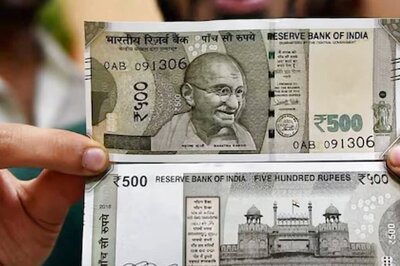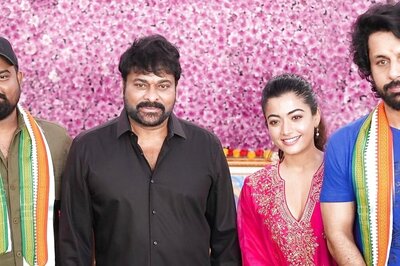
views
After the first two phases of voting for Lok Sabha elections in West Bengal, a collective sigh of relief echoed in the local media. Though sporadic incidents of violence were reported from north Bengal, there were no deaths reported, and states like Andhra Pradesh outdid Bengal in bloodletting and political violence.
Although a Congress worker was killed in a clash with TMC workers in the third phase, the relatively less murderous election season in Bengal was a welcome exception to the rule of political violence in the state. While numbers of those killed during the Left Front years between 1977 and 2011 vary wildly, West Bengal has in multiple years topped the National Crime Records Bureau’s list of the most politically violent states in India, with all the major parties, including the ruling CPI (M), claiming thousands of their workers dead.
Despite change in political dispensation in 2011, Bengal again topped the NCRB chart in 2013, accounting for 25 per cent of the political murders that took place in the entire country during the period.
In an unfortunate continuum of the murderous cult dominating Bengal’s political landscape these days, it is the ruling Trinamool Congress that stands accused of perpetuating political violence by the three main opposition parties in Bengal, the CPI(M), the Congress and the newbie to the state, the BJP.
Before dislodging the 34-year entrenched rule of the Communists in Bengal, and within sniffing distance of snatching power, Trinamool leader Mamata Banerjee’s slogan, Bodla Noy, Bodol Chai’ (We Want Change, Not Revenge), were welcome words of wisdom coming from a leader who herself had faced a life-threatening, skull-cracking assault from CPI(M) goons on August 1990 in Kolkata’s Hazra crossing.
The optimism was premature. Trinamool’s ascension to power in Bengal has seen the opposition CPM raise the flag of political violence—the CPM bore the brunt of targeted violence in rural and suburban Bengal during Banerjee’s first term as CM. The Trinamool Congress often forcibly sought to occupy positions of influence so far held by the Communists. During 2018’s panchayat polls, the Trinamool and the BJP, now eyeing the main opposition space with the Left’s retreat creating a vast void in Bengal, accused each other of dozens of political murders.
In Bengal, it is the seemingly low-key panchayat elections which represent this normalisation of political violence almost unfailingly. This psyche of resorting to violence to exert political influence at the village level possibly comes from the way rural life in Bengal is dependent on the local panchayat.
It is known that every form of dole, assistance and outreach from governments both at the state and Centre is handled by the village panchayat. While this earned the erstwhile Left Front government accolades for effective last mile implementation of the panchayati raj system, it has also meant a near total dependence of the rural folks on the grassroots institution.
It was their loss in the panchayat elections to the Trinamool preceding the 2011 assembly elections that invariably led to the fall of the Left Front government in Bengal. Trinamool knows it only too well that if you lose control over the panchayats, you lose control over Bengal.
It is equally true that unlike issues of caste and religion that dominate the politics of many other states, affiliation to political parties and ideologies are the biggest identity markers in Bengal. Since India’s Independence, political parties and ideologies in Bengal have spread and prospered over the emotive issue of land.
In the beginning of 1947, rural politics in Bengal was already galvanised by the violent Tebhaga movement, an uprising of sharecroppers demanding higher returns from the produce of the land they cultivated for landowners in undivided north Bengal. The movement was led by the Kisan Sabha of the Communist Party of India and both Charu Mazumdar, leader of the Naxalbari Movement, and Jyoti Basu, future chief minister of West Bengal and patriarch of the CPM, are known to have been associated and enthused by the Tebhaga Movement.
Understandably, their rights over the land was the core issue over which armed peasants in the small north Bengal village of Naxalbari clashed with landlords in March 1967. The fire that was lit at Naxalbari, spread like inferno to become the Naxal Movement in Bengal—a short-lived but intensely violent movement led by students, intellectuals and political activists who fought pitched battles on Kolkata streets against anybody perceived to be the class enemy and representative of the political establishment.
Hundreds of deaths were inflicted on both sides of the divide, even as there was a brutal clampdown on the Naxal movement in Bengal by the Congress government of Siddhartha Shankar Ray.
Bengal’s Naxalite movement eventually metamorphosed into the armed insurrection of the current Maoist Movement in India led by the Communist Party of India (Maoist). A key Maoist slogan of Jal, Jangal, Zameen reflects the fightback by India’s poor tribal and indigenous population for their traditional rights, a militant struggle for land and natural resources that was introduced by Bengal in the 1960s.
After the Left came to power in 1977, widespread land reforms undertaken through Operation Barga meant sharecroppers (bargadars) becoming owners of land. The popular Leftist slogan, Langol Jar, Jomi Tar (the one wielding the plough, owns the land) made millions of rural farmers loyal to both their land and the political ideology, with the spell being broken by the Singur and Nandigram land agitations by Mamata Banerjee-led Trinamool Congress against the Left government’s decision to hand over agricultural land for industry.
Again, these agitations that propelled Banerjee to power in Bengal, weren’t free of the charge of large-scale political violence and killings.
The fact that violence has preceded and accompanied every major shift in Bengal’s politics flies against the face of the British branding Bengalis as a non-martial race post the Sepoy Mutiny of 1857. Part of the reason the British felt so, it is said, is the overwhelming number of Bengali soldiers who revolted against the British during the mutiny, which was initially triggered by the Bengal section of the army based in Barrackpore, close to Kolkata.
If Bengal’s role in taking the first rebellious step towards driving the British out of the land and country was reserved with the Sepoy Mutiny of 1857, very soon another land agitation by exploited Indigo farmers in Bengal would rock the British establishment.
The Indigo Mutiny of the late 1850s, when the aggressive peasants movement was violently repressed by the British, was also among the first instance when Bengali bhadrolok society—a class of mostly economically well-off, well-educated and mild-mannered people that was coalescing influentially in those early days of British rule in India—would encounter the horrors of political violence and gather in support of the victims.
This was exemplified by the way the subversive imagination of Bengali educated youth was fired after Dinabandhu Mitra’s play, Neel Dorpon, chronicling the Indigo Mutiny, became popular.
Since then, political violence has often been romanticised in Bengali bhadralok society as bloodletting for a higher cause. It has seen the rise of Bengali nationalism against British rule. Hundreds of educated Bengali youth, like Aurobindo Ghosh, Khudiram Bose, Prafulla Chaki, Surya Sen, Kanai Dutta, Satyen Bose, the trio of Binoy-Badal-Dinesh, Rashbehari Bose and of course, his long-time friend. Subhas Chandra Bose, along with militant organisations like Anushilan Samiti and Jugantor took the armed route to achieving freedom from British rule for India.
While the upsurge in militant Bengali nationalism was one of the reasons for the shift of British India’s capital from Kolkata to Delhi in 1911, and their eventual departure from India in 1947, history books and folklore recounted to children in Bengal is replete with the bloody sacrifices of Bengal’s pantheon of revolutionary freedom fighters.
From fighting for the country and the rights of the downtrodden, political violence in Bengal’s recent past has been reduced often to mere vendetta politics and selfishly safeguarding political ground. For good or bad, violence has had a phantasmal and ubiquitous presence in Bengali life. A little over 150 years since the British deemed Bengalis as a non-martial race, news reports indicate that Bengal is now the sixth highest contributor among all states to the Indian Army -- an attestation to the Bengali brawn over the much-feted brain.
(The author is a Kolkata-based freelance journalist. Views are personal)




















Comments
0 comment